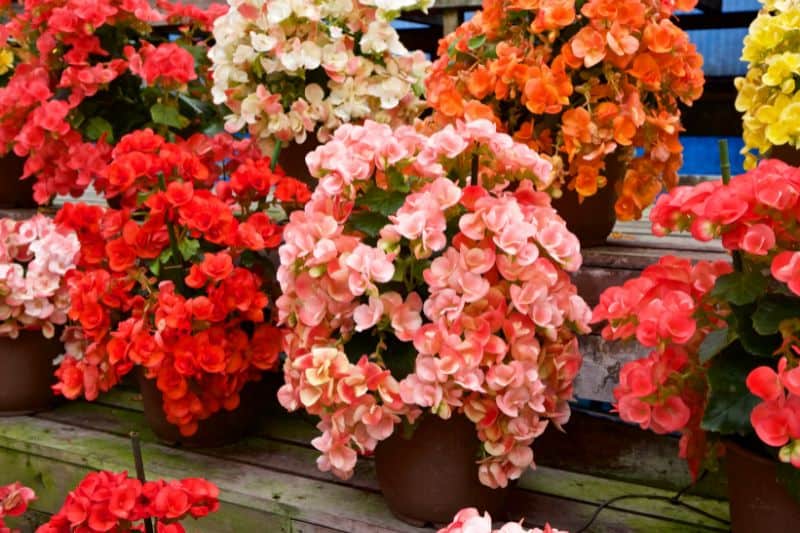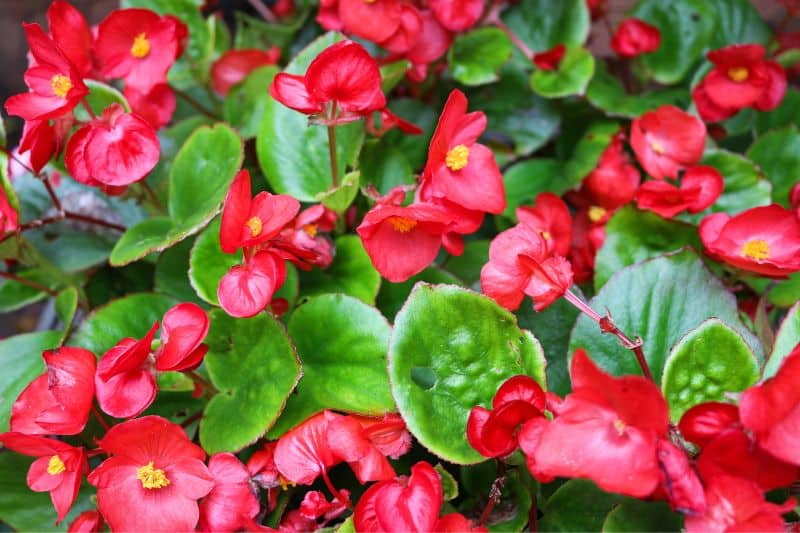Do you plan on adding begonias to your flower bed? Before incorporating these annual plants, it’s best to know the conditions in which they thrive the most. So, part of the important questions to ask yourself is, do begonias need full sun?
Begonias are popular for their distinctively elegant and light-shaded blossoms that grow against glossy green foliage to enliven any garden. You can even find full foliage varieties with intricate patterns and shapes to give your indoor and outdoor space a unique look. However, their edibility also makes these annual plants a gardener’s favorite.
Most begonias extend your garden’s beauty onto your plate, whether added to a decadent floral cake recipe or a crisp summer salad. To enjoy the most beautiful blossoms and bountiful green foliage, find out whether begonias need full sunlight here.
Read: Do Blueberries Need Full Sun? (Answered)
Do Begonias Need Full Sun or Shade?
The degree to which begonias need full sun or shade varies on the variety. Begonias are divided into three key categories based on their root systems. These include tuberous, fibrous-rooted, hardy, and foliage begonias. Some of these varieties slightly differ in their light needs.
Generally, begonias prefer dappled sun or partial shade conditions. This means that they thrive best in part shade and part sunlight. Too much sun can cause their leaves to scorch and dry out. These lighting conditions are sufficient enough for begonias to thrive and flourish.
In partial shade, different varieties of begonias grow the best. If achieving the best shade is your priority, you will love the bright and intense red, pink, orange, and yellow shades, among others, achieved in these conditions.
Similarly, begonias growing in pots and hanging baskets produce the most aesthetically pleasing cascading blooms. However, you can still find a few varieties, like the wax begonias that are a little more forgiving. These versatile varieties can thrive in extended periods of sunlight exposure.
Can Begonias Get Too Much Sun?
Begonias can get too much sun, which leads to extreme damage to the plant. Exposing begonias to direct sunlight for more than 6 hours, especially the afternoon sun can harm them. If you notice your begonias beginning to wilt, develop yellow or brown spots, and even the flowers dying, your plant may be getting too much sun.
Begonias exposed to extreme direct sunlight for a long period may also experience color fading on their flowers or stunted plant growth. You have to take particular care if you live in a hot climate. In these conditions, you should limit your begonia’s direct morning sun exposure to no more than 4 hours.
Further, you should avoid direct afternoon sun exposure at all costs. After a few hours of direct morning sun exposure, you can follow this up with placement in a shaded area or indirect light.
Nonetheless, it’s worth noting that too little sun exposure can also affect begonias. There needs to be a balance between partial sunlight and shade. For most begonia varieties, this is achieved through direct morning sun exposure for 3 to 6 hours followed by placement in shady areas or indirect sunlight in the afternoon.
Begonias lacking adequate sunlight exposure develop powdery mildew. Powdery mildew is a foliage, stem, or flower fungal disease and is exhibited through its whitish to grayish growth on these parts of the plant.
Moreover, sun-deprived begonias exhibit irregular growth. They grow extremely tall and long although instead of their usual shape. Additionally, they don’t grow as big compared to healthier ones.

How Many Hours of Sun Do Begonias Need?
Begonias require at least 3 to 6 hours of direct sunlight per day. But, you should avoid exposing the plants to the afternoon sun. Instead, these plants prefer the less harsh and intense morning sun. You can then follow this up with placement in a shady spot or indirect sunlight in the afternoon.
However, some types, like the wax begonias and dragon wing begonias that fall under the fibrous begonia varieties have slightly different sunlight needs.
Unlike most begonias, these types of fibrous begonias require up to 8 hours of full sunlight exposure, from morning to afternoon. While they will survive in 3 to 6 hours of morning sunlight, you get the best results with up to 8 hours of exposure.
Wax and dragon wing begonia’s exposure to less than 6 hours of sunlight may produce fewer blossoms – which are not as lush and illustrious.
On the other hand, foliage begonias survive in the least sunlight, explaining why they thrive even as houseplants. You can also place them in shady parts of your flower bed, where they enjoy indirect sunlight.
Types of Begonias and Their Sunlight Requirements
As mentioned above, begonias survive best in partial shade or dappled light, so you can grow them in shady spots. But, the actual range of partial sunlight different types of begonias need also varies. Here are the main types of begonias and their sunlight requirements;
Tuberous begonias grow from round fleshy tubers that produce large and showy colorful blossoms. These include red, pink, orange, yellow, and white blossoms that appear from summer through fall. The most common types of tuberous begonias include Rex Begonias and Non-Stops.
You can plant them on flower beds, pots, or hanging containers. Compared to other more forgiving begonias, tuberous begonias require a balance of shade and sunlight. These begonias thrive best in partial shade and partial sun. Exposure to the morning sun for 4 to 6 hours a day is more than enough.
Fibrous begonias are seed-propagated and develop thin and fibrous roots. Wax begonias are the common types of these varieties, typically developing small leaves and flowers. You can grow fibrous begonias in garden beds, shady borders, containers, or window boxes.
Fibrous begonias, such as wax and dragon wing begonias can thrive in the most sunlight exposure compared to other varieties. These versatile begonias can thrive in both partial shade and full sunlight, making them incredibly versatile. These begonias can take up to 8 hours of sunlight per day.
Hardy begonias are cold weather resistant and typically grown in the garden where they are left during the winter season. These varieties thrive in partial shade with some sunlight.
Hardy begonias can tolerate between 3 and 6 hours of direct morning sunlight. While they can take some afternoon sunlight, they must be protected from extended exposure to prevent sun damage.
Foliage begonias, as their name suggests, are grown for their impressive foliage. They come in varying shapes, patterns, and colors and are usually grown as houseplants.
However, you can also grow them outdoors in the summer, whether in the garden, patio, or a shady border. Foliage begonias survive best in partial shade and partial sun. 3 to 6 hours of morning sunlight exposure is enough for these begonia varieties.

Can Begonias Grow in Indirect Sunlight?
Begonias grow just fine in indirect sunlight. Since most varieties are not fully sunlight tolerant, growing in areas with dappled light is the best option. Growing them in indirect sunlight protects them from potential sun damage and heat stress caused by direct sunlight.
But, growing begonias also comes with its limitations. Begonias need direct sunlight to a certain degree. Ideally, these plants should be exposed to 3 to 6 hours of morning sunlight before continuing with indirect sunlight for the rest of the day.
Varieties, like the fibrous wax begonias, need longer exposures to sunlight – up to 8 hours before moving to indirect sunlight. However, begonias growing indoors, like the foliage or some hardy begonias will do just fine with indirect sunlight alone.
Foliage and some hardy begonias can be planted as houseplants. Consider their lighting requirements if you are considering incorporating them into your houseplant lineup. As houseplants, begonias should always be placed where they receive indirect sunlight exposure throughout the day.
So, you want to avoid placing them in areas with direct sunlight exposure, like a south-facing window sill.
Can Begonias Grow in Shade?
Begonias can grow in shade. However, it’s important to understand the full conditions under which begonias thrive. Sure, these plants can grow in the shade. But, they require some light exposure for a few hours a day to fully thrive.
Most begonias prefer the less intense morning sunlight and shade in the afternoon when the temperatures are high. Even varieties, like the Wax Begonia, which prefers more sunlight exposure benefit from shade for a few hours a day. On the other hand, indoor houseplants thrive in areas with indirect light, rather than direct sunlight exposure.
Read: Do Strawberries Need Full Sun? (Answered)
How To Grow and Care For Begonias?
- When growing begonias, space each plant at least 12 inches from another in a garden bed and slightly closer in pots or containers
- Plant seeds underneath the seed starter mix in a pot in a seed starter pot, avoiding burying the seeds too deep. This is because the pressure of the soil mix can prevent seed germination.
- Once done, spray the surface of the soil mix with water using a spray bottle.
- Loosely cover the soil mix and seeds using plastic wrap to keep the environment warm and humid and transfer the pot to a warm and shaded area.
- Expose the pot to at least 12 to 14 hours of light daily.
- After 15 to 16 weeks, transfer the now-grown seedlings into the garden bed or larger pot or container
- Alternatively, Add trimmed begonia stems (about 4 inches long) into moist, peat-free potting soil mix in a container or garden bed
- Grow begonias in springtime when there is no longer a threat of spring frost
- As usual, store begonias in partial shade or dappled sun – exposing the plants to direct morning sunlight alone
- Ideally, grow foliage begonias as houseplants
- Water begonias regularly – at least every 2 to 4 days
- Apply all-purpose fertilizer weekly to monthly. For tuberous begonias, use a slow-release fertilizer to prevent burning the roots and plant.
- Begonias are low maintenance and don’t require deadheading – they are self-cleaning!
- You can store fibrous begonias during the winter to protect them from frost and replant them in spring
- Alternatively, treat them as annual plants and discard them into your compost heaps.
- Dig up tuberous begonias and store their tubers in a cool and frost-free area during winter






